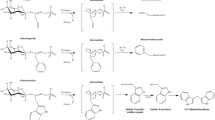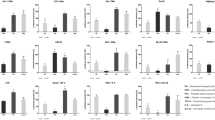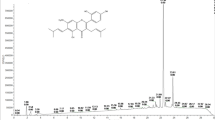Abstract
For the discovery of new cancer chemopreventive agents, we have studied the potential of plant extracts to inhibit phorbol ester-induced ornithine decarboxylase (ODC) activity in cell culture. Four active rotenoids were obtained from the African plant Mundulea sericea (Leguminosae). These isolates were highly potent when evaluated for inhibition of chemically induced preneoplastic lesions in mammary organ culture and inhibition of papillomas in the two-stage mouse skin model, and they appear to function by a unique mechanism at the level of ODC messenger RNA expression. Based on our findings, rotenoids can be regarded as promising new chemopreventive or anticancer agents.
This is a preview of subscription content, access via your institution
Access options
Subscribe to this journal
Receive 12 print issues and online access
$209.00 per year
only $17.42 per issue
Buy this article
- Purchase on Springer Link
- Instant access to full article PDF
Prices may be subject to local taxes which are calculated during checkout
Similar content being viewed by others

Change history
01 June 1995
HIV-speciflc cytotoxic T-cells in HIV-exposed but uninfected Gambian women S. Rowland-Jones, J. Sutton, K. Ariyoshi, T. Dong, F. Gotch, S. Mcadam, D. Whitby, S. Sabally, A. Gallimore, T. Corrah, M. Takiguchi, T. Schultz, Andrew Mcmichael & H. Whittle Nature Medicine 1, 59–64, 1995. An error in typography resulted in the incorrect printing of m for the Greek character μ.
References
Sporn, M.B. & Newton, D.L. Chemoprevention of cancer with retinoids. Fed. Proc. 38, 2528–2534 (1979).
Wattenberg, L.W. Chemoprevention of cancer. Cancer Res. 45, 1–8 (1985).
Talaly, P. The role of enzyme induction in protection against carcinogenesis. Cancer Chemoprevention (Wattenberg, Lipkin, Boone & Kelloff eds.) 469–478 (CRC Press, Boca Raton, FL, 1992).
Kelloff, G.J. et al. Chemopreventive drug development: Perspectives and progress. Cancer Epidemiol. Biomarkers & Prev. 3, 85–98 (1994).
Szarka, C.E., Grana, G. & Engstrom, P. Chemoprevention of cancer. Curr. Probl. Cancer 18, 1–78 (1994).
Boutwell, R.K. Biochemical mechanism of tumour promotion. Carcinogenesis, Vol. 2. Mechanism of Tumour Promotion and Cocarcinogenesis (Slaga, Sivak & Boutwell, eds.) 49–58 (Raven Press, New York, 1978).
Pezzuto, J.M., Cancer Chemopreventive agents: from plant materials to clinical trials. Human Medical Agents from Plants (ACS Symposium Series No. 534) (Kinghorn & Balandrin, eds.) 205–217 (American Chemical Society Books, Washington, DC, 1993).
Pezzuto, J.M. Nalural products cancer chemopreventive agents. Recent Adv. Phytochem. 29 (in the press).
Peña, A. et al. Regulation of human ornithine decarboxylase expression by the c-Myc•Max protein complex. J. biol. Chem. 268, 27277–27285 (1993).
McCann, P.P. & Pegg, A. Ornithine decarboxylase as an enzyme target for therapy. Pharmacol. Ther. 54, 195–215 (1992).
Van Daalen Wetters, T., Brabant, M. & Coffino, P. Regulation of ornithine decarboxylase activity by cell growth, serum and tetradecanoyl phorbol acetate is governed primarily by sequences within the coding region of the gene. Nucleic Acids Res. 17, 9843–9860 (1989).
Auvinen, M., Paasinen, A., Andersson, L.C. & Hölttä, E. Ornithine decarboxylase activity is critical for cell transformation. Nature 360, 355–358 (1992).
Luyengi, L. et al. Rotenoids and chalcones from Mundulea sericea with ornithine decarboxylase inhibiting activity. Phytochemistry 36, 1523–1526 (1994).
Verma, A.K. Inhibition of tumour promoter 12-O-tetradecanoylphorbol-13-acetate-induced synthesis of epidermal ornithine decarboxylase messenger RNA and diacylglycerol-promoted mouse skin tumour formation by retinoic acid. Cancer Res. 48, 2168–2173 (1988).
Verma, A.K., Pong, R.-C. & Erickson, D. Involvement of protein kinase C activation in ornithine decarboxylase gene expression in primary culture of newborn mouse epidermal cells and in skin tumour promotion by 12-O-tetradecanoylphorbol-13-acetate. Cancer Res. 46, 6149–6155 (1986).
Konoshima, T. et al. Studies on inhibitors of skin tumour promotion, XII. Rotenoids from Amorpha fruticosa . J. Nat. Prod. 56, 843–848 (1993).
O'Brien, R.D., Rotenoids. Insecticides. Action and Metabolism 159–163 (Academic Press, New York, 1967).
Fukami, H. & Nakajima, M. Rotenone and rotenoids. Naturally Occurring Insecticides 71–97 (Dekker, New York, 1971).
Burgos, J. & Redfearn, E.R. The inhibition of mitochondrial reduced nicotinamide-adenine dinucleotide oxidation by rotenoids. Biochim. biophys. Acta 110, 475–483 (1965).
Marshall, L.E. & Himes, R.H. Rotenone inhibition of tubulin self-assembly. Biochim. biophys. Acta 543, 590–594 (1978).
Anzeveno, P.B., Rotenoid Interconversion. Synthesis of deguelin from rotenone. J. org. Chem. 44, 2578–2580 (1979).
O'Brien, T.G. The induction of ornithine decarboxylase as an early, possibly obligatory event in mouse skin carcinogenesis. Cancer Res. 36, 2644–2653 (1976).
Lu, Y.-P., Chang, R.L., Huang, M.-T. & Conney, A.H. Inhibitory effect of curcumin on 12-O-tetradecanoylphorbol-13-acetate-induced increase in ornithine decarboxylase mRNA in mouse epidermis. Carcinogenesis 14, 293–297 (1993).
Wagner, A.J., Meyers, C., Laimins, L.A. & Hay, N. c-Myc induces the expression and activity of ornithine decarboxylase. Cell Growth Differ. 4, 879–883 (1993).
Bello-Fernandez, C. & Cleveland, J.L. C-myc transactivates the ornithine decarboxylase gene. Curr. Topics Microbiol. Immunol. 182, 445–452 (1992).
Kakar, S.S. & Roy, D. Curcumin inhibits TPA-induced expression of c-fos, c-jun and c-myc proto-oncogenes messenger RNAs in mouse skin. Cancer Lett. 87, 85–89 (1994).
Lichti, U. & Gottesman, M.M. Genetic evidence that a phorbol ester tumor promoter stimulates ornithine decarboxylase activity by a pathway that is independent of cyclic AMP-dependent protein kinases in CHO cells. J. Cell Physiol. 113, 433–439 (1982).
Lowry, O.H., Rosebrough, N.J., Farr, A.L. & Randall, R.J. Protein measurement with the folin phenol reagent. J. biol. Chem. 193, 265–275 (1951).
Chomczynski, P. & Sacchi, N. Single-step method of RNA isolation by acid guanidinium thiocyanate-phenol-chloroform extraction. Anal. Biochem. 162, 156–159 (1987).
Kroczek, R.A. & Siebert, E. Optimization of northern analysis by vacuum-blotting, RNA-transfer visualization, and ultraviolet fixation. Anal. Biochem., 184, 90–95 (1990).
De Vries, D.J., Herald, C.L., Pettit, G.R. & Blumberg, P.M. Demonstration of sub-nanomolar affinity of bryostatin 1 for the phorbol ester receptor in rat brain. Biochem. Pharmacol. 37, 4069–4073 (1988).
Da Silva, C., Fan, X., Martelly, I. & Castagna, M. Phorbol ester mediated phospholipid-free activation of rat brain protein kinase C. Cancer Res. 50, 2081–2087 (1990).
Chen, I.-S. et al. Chemical and bioactive constituents from Zanthoxylum simulans . J. Nat. Prod. 54, 1206–1211 (1994).
McCormick, D.L. & Moon, R.C. Antipromotional activity of dietary N-(4-hydroxyphenyl) retinamide in two-stage skin tumourigenesis in CD-1 and Sencar mice. Cancer Lett. 31, 133–138 (1986).
Mehta, R.G., Steele, V., Kelloff, G.J. & Moon, R.C. Influence of thiols and inhibitors of prostaglandin biosynthesis on the carcinogen-induced development of mammary lesions in vitro . Anticancer Res. 11, 587–592 (1991).
Author information
Authors and Affiliations
Rights and permissions
About this article
Cite this article
Gerhäuser, C., Mar, W., Lee, S. et al. Rotenoids mediate potent cancer chemopreventive activity through transcriptional regulation of ornithine decarboxylase. Nat Med 1, 260–266 (1995). https://doi.org/10.1038/nm0395-260
Received:
Accepted:
Published:
Issue Date:
DOI: https://doi.org/10.1038/nm0395-260
This article is cited by
-
Improvement of cytotoxicity of mitoxantrone and daunorubicin by candidone, tephrosin, and bavachinin
Molecular Biology Reports (2021)
-
Asymmetric total synthesis of rotenoids via organocatalyzed dynamic kinetic resolution
Communications Chemistry (2019)
-
Molecular interaction studies of Deguelin and its derivatives with Cyclin D1 and Cyclin E in cancer cell signaling pathway: The computational approach
Scientific Reports (2019)
-
Synthesis of some novel pyrano[2,3-f]chromenone derivatives
Journal of the Iranian Chemical Society (2015)
-
Efficacy and mechanism of action of Deguelin in suppressing metastasis of 4T1 cells
Clinical & Experimental Metastasis (2013)


